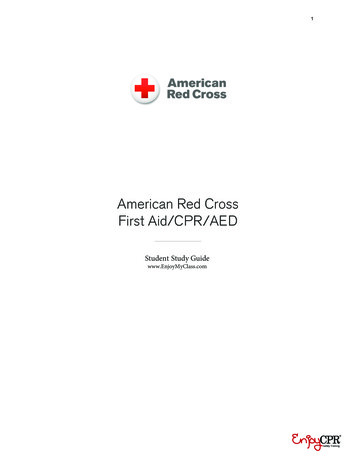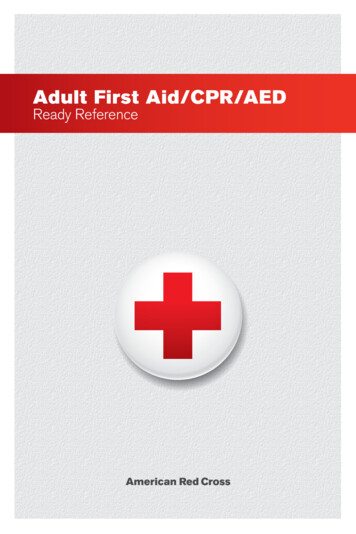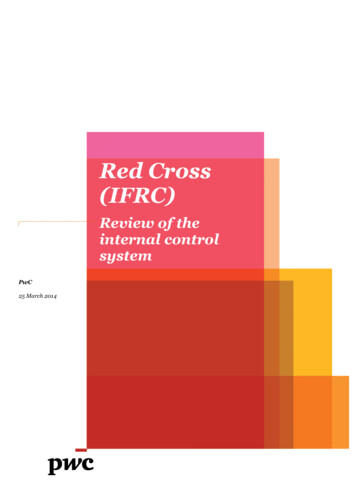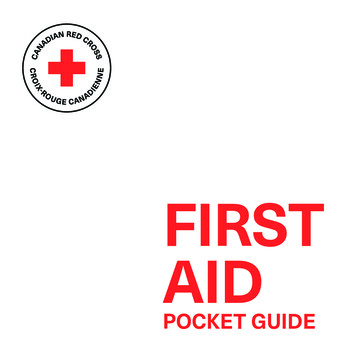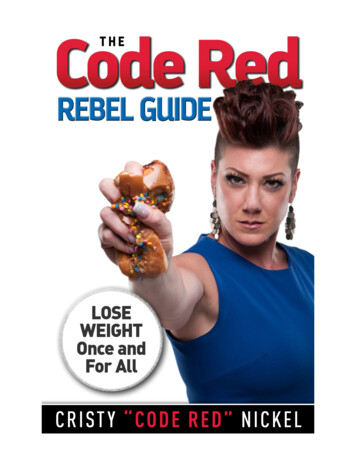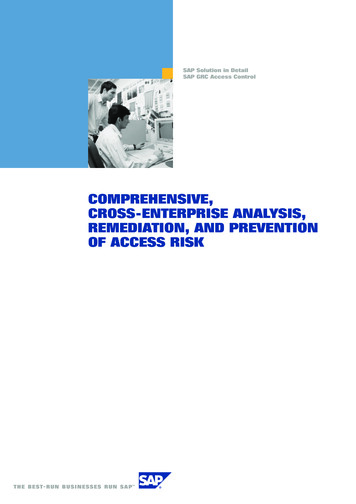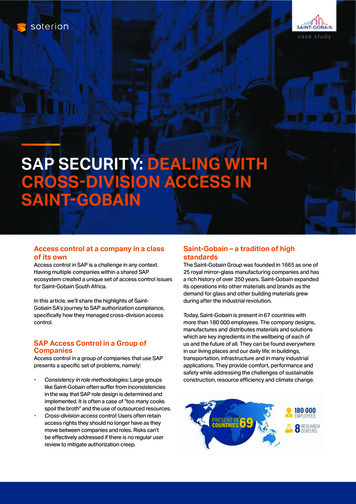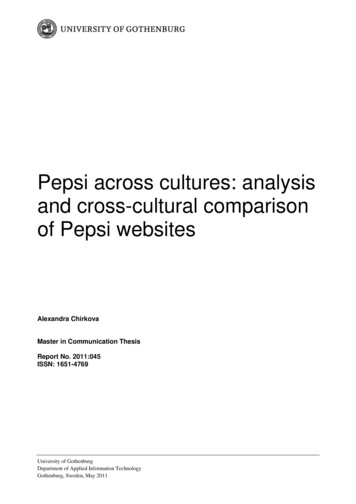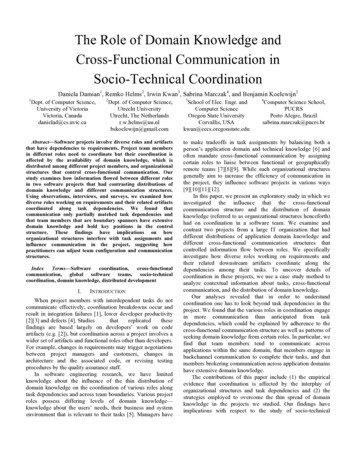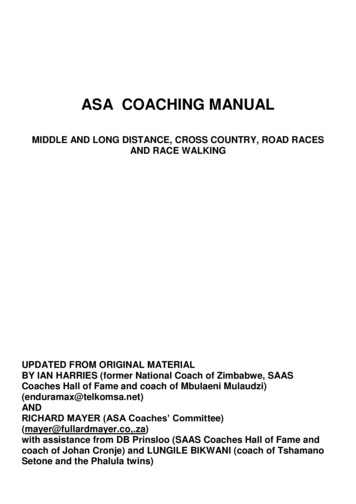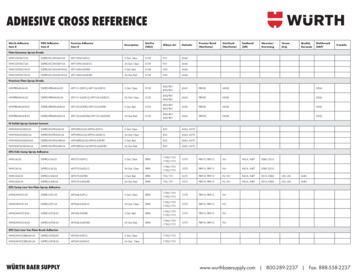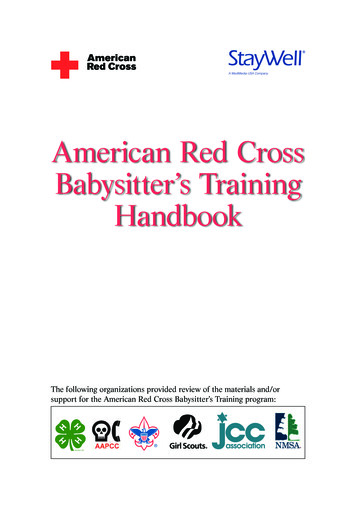
Transcription
American Red CrossBabysitter’s TrainingHandbookThe following organizations provided review of the materials and/orsupport for the American Red Cross Babysitter’s Training program:BST FM i-vi.indd i2/20/08 8:03:00 AM
Copyright 2008 by The American National Red CrossAll rights reserved. No part of this publication may be reproduced, stored in a retrievalsystem or transmitted in any form or by any means, electronic, mechanical, photocopying,recording or otherwise, without prior permission from American Red Cross NationalHeadquarters, Preparedness and Health and Safety Services.Content reflects the 2005 Consensus on Science for CPR and Emergency CardiovascularCare (ECC) and the 2005 Guidelines for First Aid.American Red Cross certificates may be issued upon successful completion of a trainingprogram, which uses this manual as an integral part of a course. By itself, the material inthis handbook does not constitute comprehensive Red Cross training. In order to issueRed Cross certificates, your instructor must be authorized by the American Red Cross, andmust follow prescribed policies and procedures. Make certain that you have attended acourse authorized by the Red Cross. Contact your local American Red Cross chapter(www.redcross.org) for more information.The emergency care procedures outlined in this manual reflect the standard of knowledgeand accepted emergency practices in the United States at the time this manual waspublished. It is the reader’s responsibility to stay informed of changes in the emergency careprocedures.Printed in the United States of AmericaPrinting/Binding by RR DonnellyStayWell780 Township Line Rd.Yardley, PA 19067ISBN: 978-1-58480-313-308 09 10 11 12 9 8 7 6 5 4 3 2 1BST FM i-vi.indd ii2/20/08 8:03:05 AM
AcknowledgmentsThe American Red Cross Babysitter’s Training program and supportingmaterials were developed through the dedication of both employees andvolunteers. Their commitment to excellence made this program possible.The American Red Cross and StayWell thank Kristin Atwell, MichaelAtwell, David Baker, Elina Berglund, Charles Boyce Brooks III, JulietChukwu, Meghan Gordineer, Julionna Hackett, Kylee Anne Hackett,Audrey Heller, Anne Mammel, Ashley Radley, Juliana Saucedo and NatalieScalabrino for their guidance and review. The American Red Cross andStayWell also thank Vincent Knaus, photographer, and Tamara Lazarus,producer, for their efforts.American Red Cross’ Advisory Council on First Aid, Aquatics, Safety andPreparednessIn late 1998, the Red Cross formed an independent panel of nationallyrecognized health and safety experts known as the Advisory Council onFirst Aid, Aquatics, Safety and Preparedness or ACFASP. Drawing on abody of collective expertise from such diverse fields as emergency medicine,occupational health, sports medicine, school health, emergency medicalservices (EMS) response and disaster mobilization, ACFASP helps establishthe standard in first aid care. ACFASP advises the Red Cross in areasrelated to the development and dissemination of audience-appropriateinformation and training in first aid, aquatics, safety and preparedness.ACKNOWLEDGMENTSBST FM i-vi.indd iiiiii2/20/08 8:03:05 AM
ContentsCHAPTER 1CHAPTER 3You’re The Boss:A Guide toLeadership . . . . . . . 1Safe and Sound onthe Job . . . . . . . . . .31How to Be a Leader . . . . . . . . . . . . . . . 2Personal Safety . . . . . . . . . . . . . . . . . . 33Leadership Skills. . . . . . . . . . . . . . . . . . 3Danger from Strangers. . . . . . . . . . . 33Telephone Safety Tips . . . . . . . . . . . . 32Other Safety Considerations. . . . . . 34CHAPTER 2The Business ofBabysitting . . . . . .13Safety Inspection Checklist . . . . . . . 35Preventing Accidents andInjuries. . . . . . . . . . . . . . . . . . . . . . . 39What Kind of Babysitter Are You? . 13Being Prepared for WeatherEmergencies . . . . . . . . . . . . . . . . . 52Getting Started . . . . . . . . . . . . . . . . . . 14Violence or Crime . . . . . . . . . . . . . . . . 54Finding Work . . . . . . . . . . . . . . . . . . . . 15Play It Safe! . . . . . . . . . . . . . . . . . . . . . . 54Interviewing the Family . . . . . . . . . . 19Professional Behavior . . . . . . . . . . . . 22CHAPTER 4Understanding Kidsfrom 0 to 10 . . . . .58Ages, Stages and Milestones . . . . . 59Children and Play . . . . . . . . . . . . . . . . 64Helping Children Behave . . . . . . . . . 69ivBST FM i-vi.indd ivCONTENTS2/20/08 8:03:06 AM
CHAPTER 5CHAPTER 6From Feedingto Bedtime:Caring for Kids . . .82It’s An Emergency Now What? . . . . .111Talking to the Parents About BasicChild Care . . . . . . . . . . . . . . . . . . . . 83In a First Aid Emergency: CHECK—CALL—CARE. . . . . . . . . . . . . . . . 113Watching Out for Germs. . . . . . . . . . 83Calling for Help . . . . . . . . . . . . . . . . . 114Picking Up and Holding Children. . . 85Checking a Conscious Child orInfant . . . . . . . . . . . . . . . . . . . . . . . 117Feeding Children . . . . . . . . . . . . . . . . 86What Is an Emergency?. . . . . . . . . . 112Diapering . . . . . . . . . . . . . . . . . . . . . . . 88What Is a BreathingEmergency? . . . . . . . . . . . . . . . . . 119Dressing Children. . . . . . . . . . . . . . . . 89Asthma . . . . . . . . . . . . . . . . . . . . . . . . 120Bathing Toddlers. . . . . . . . . . . . . . . . . 90Choking . . . . . . . . . . . . . . . . . . . . . . . . 121Rest and Sleep. . . . . . . . . . . . . . . . . . . 91Skill Sheet: Hand Washing . . . . . . . . 93Unconscious Children andInfants . . . . . . . . . . . . . . . . . . . . . . 123Skill Sheet: Removing DisposableGloves . . . . . . . . . . . . . . . . . . . . . . . 95I’m Hot: What to do When a Childor an Infant Has a Fever . . . . . . 124Skill Sheet: Picking Up Infants . . . . 97Bleeding Emergencies . . . . . . . . . . 129Skill Sheet: Holding Infants—Cradle Hold . . . . . . . . . . . . . . . . . . 98Types of Wounds. . . . . . . . . . . . . . . . 129Skill Sheet: Holding Infants—Shoulder Hold . . . . . . . . . . . . . . . . 99Skill Sheet: Picking Up and HoldingToddlers—Upright Carry . . . . . 100Skill Sheet: Bottle-Feeding . . . . . . 101Skill Sheet: Spoon-Feeding . . . . . . 103Skill Sheet: Diapering . . . . . . . . . . . 105Skill Sheet: Checking a ConsciousChild or Infant . . . . . . . . . . . . . . . 132Skill Sheet: Conscious Choking—Child. . . . . . . . . . . . . . . . . . . . . . . . 135Skill Sheet: Conscious Choking—Infant . . . . . . . . . . . . . . . . . . . . . . . 136Skill Sheet: Checking anUnconscious Child or Infant . . 137Skill Sheet: Undressing Children . 108Skill Sheet: Rescue Breathing—Child or Infant . . . . . . . . . . . . . . . 139Skill Sheet: Dressing Children inSnap or Button Shirts . . . . . . . . 109Skill Sheet: Controlling ExternalBleeding . . . . . . . . . . . . . . . . . . . . 140Skill Sheet: Dressing Childrenin a T-Shirt. . . . . . . . . . . . . . . . . . . 110CONTENTSBST FM i-vi.indd vv2/20/08 8:03:16 AM
CHAPTER 7Fainting . . . . . . . . . . . . . . . . . . . . . . . . 156First Aid, CPR andAED . . . . . . . . . . . .141Diabetic Emergencies . . . . . . . . . . . 156Good Samaritan Laws . . . . . . . . . . . 142Obtaining Consent. . . . . . . . . . . . . . 142Seizures . . . . . . . . . . . . . . . . . . . . . . . . 156Poisoning . . . . . . . . . . . . . . . . . . . . . . 157Allergic Reaction. . . . . . . . . . . . . . . . 157Heat-Related Emergencies . . . . . . 157Recognizing and Caring forShock . . . . . . . . . . . . . . . . . . . . . . . 143Cold-Related Emergencies . . . . . . 158Moving a Child or an Infant. . . . . . 144Skill Sheet: CPR—Child. . . . . . . . . . 159The Cardiac Chain of Survival. . . . 149Skill Sheet: CPR—Infant . . . . . . . . . 160CPR—Child and Infant . . . . . . . . . . 149Skill Sheet: Unconscious Choking—Child or Infant . . . . . . . . . . . . . . 161AED . . . . . . . . . . . . . . . . . . . . . . . . . . . . 150Unconscious Choking—Child andInfant . . . . . . . . . . . . . . . . . . . . . . . 151Injuries to Muscles, Bones andJoints . . . . . . . . . . . . . . . . . . . . . . . 151Skill Sheet: Applying aSoft Splint. . . . . . . . . . . . . . . . . . . 163Skill Sheet: Applying a Sling andBinder . . . . . . . . . . . . . . . . . . . . . . 165Head, Neck and Back Injuries . . . . 152Sudden Illness . . . . . . . . . . . . . . . . . . 153viBST FM i-vi.indd viReferences. . . . . .166CONTENTS2/20/08 8:03:16 AM
CHAPTER 1You’rethe Boss:A Guide toLeadershipBabysitting is a bigresponsibility. Are youready for the challenge?What happens if the kids don’t listenwhen you tell them it is time for bed?What will you do if a stranger comes tothe door? How will you handle fightingor temper tantrums? As the babysitter,you’re the leader. Parents rely on you tokeep their children safe when they areaway. Children look up to you as theperson in charge. In this chapter you willlearn the leadership skills you will needto meet these challenges.BST Ch01 001-012.indd 12/20/08 7:38:04 AM
1How to be a LeaderA leader is a person who guides and motivates others towards a commongoal. In babysitting, the people you’ll be motivating will be the children inyour care. The common goal will be keeping everyone safe, respecting thefamily’s rules and routines and having fun.There are a lot of ways to lead children and some babysitters may findthat some leadership styles are more natural for them than others. Youmay not remember the names of the styles and that’s okay; knowing howand when to use each leadership style will help you while you’re on thejob. In most cases, the leadership style that you use will depend on thecircumstances.If the kids you are babysitting are trying to make a decision that affectseveryone but doesn’t involve safety, it’s best to use a democratic leadershipstyle. For example, if the children can’tdecide whether to go to the park or watcha DVD, don’t immediately decide forthem. Instead, ask each child to say whathe or she prefers to do and try to workthrough the decision together. Try to keepthe discussion positive. This approachallows each child to feel like his or heropinions are listened to and respected.If the children are getting along verywell and no important decisions needto be made, you can probably use ahands-off leadership style. For example,if three sisters have been playing a board gamewithout any conflicts and a slight disagreement comes up, you don’t needto step in. In a case like this, you can just let the girls work things out ontheir own. Using the hands-off leadership style can keep you from seemingtoo bossy and it gives the children an opportunity to learn how to solvedisagreements on their own. If the conflict gets worse or the children can’tresolve the problem themselves, then it’s time for you to step in and takeaction.When you are just getting to know the children or when emotions arerunning high, the sympathetic leadership style works well. A sympatheticleader focuses on making people feel valued and cared for. This style worksbest in situations where it is more important to focus on how people feel thanon how they are acting, like when you are babysitting a brother and sister2YOU’RE THE BOSS: A GUIDE TO LEADERSHIPBST Ch01 001-012.indd 22/20/08 7:38:15 AM
who both want your attention. If they are safe and not hurting each other,then take your time and listen to what each child has to say and ignore theirminor attention-seeking behavior. By focusing on the children’s feelings andtaking the time to listen to their concerns, you can earn their trust.Sometimes a babysitter needs to make an important decision quickly andhas to tell the children what to do with little or no discussion. You will needto use the directive leadership style in emergencies and when you are tryingto prevent an injury. For example, if one child is about to hit another childwith a stick, you must tell the child to stop and take the stick away. You don’thave time to discuss the situation because immediate action is needed.1Leadership SkillsEveryone can learn to be a leader. As with otherskills, the more you practice leadership skills,the better leader you will be. Practice thefollowing to improve your leadership skills: Role modeling Respect Communication Motivation Taking action Decision makingRole ModelingA role model sets an example for others to follow. Modeling good behavioris important because the children you babysit will look up to you andfollow the example you set. Role modeling is also one of the simplest waysto lead. For example, always washing your hands before preparing or eatingfood will help you encourage the children to wash their hands. You can bea good role model by— Following household rules. Following the parent’s instructions. Having a positive attitude. Making the best out of difficult situations. Leading by example. Focusing on safety. Showing enthusiasm.YOU’RE THE BOSS: A GUIDE TO LEADERSHIPBST Ch01 001-012.indd 332/20/08 7:38:19 AM
1RespectRespecting Household RulesAn important part of being a good leader is knowing what is expected ofyou. The parents for whom you babysit will have specific instructions forhow they want you to handle certain situations. Respect and follow all thehousehold rules, even if they are different from your own. The children willbe happier, feel more secure and behave better if you follow their usualroutines.Respecting DiversityPeople are alike in many ways. In other ways,people are very different. These differencesare called diversity. Diversity is a good thing.Without diversity, everyone would be exactlythe same and that would make the world avery boring place. Accept each child assomeone special. Being respectful of other’sdiversity also means recognizing how yourown culture and beliefs might affect howyou get along with children who aredifferent from you. Respecting diversity isa great way to model respect and courtesyand will help you become a bettercommunicator. Respect each family’s andchild’s diversity. You may find that thechildren you babysit are diverse in t
American Red Cross’ Advisory Council on First Aid, Aquatics, Safety and Preparedness In late 1998, the Red Cross formed an independent panel of nationally recognized health and safety experts known as the Advisory Council on First Aid, Aquatics, Safety and Preparedness or ACFASP. Drawing on a body of collective expertise from such diverse fi elds as emergency medicine, occupational health .
